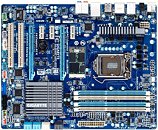- Joined
- Oct 9, 2007
- Messages
- 47,880 (7.38/day)
- Location
- Dublin, Ireland
| System Name | RBMK-1000 |
|---|---|
| Processor | AMD Ryzen 7 5700G |
| Motherboard | Gigabyte B550 AORUS Elite V2 |
| Cooling | DeepCool Gammax L240 V2 |
| Memory | 2x 16GB DDR4-3200 |
| Video Card(s) | Galax RTX 4070 Ti EX |
| Storage | Samsung 990 1TB |
| Display(s) | BenQ 1440p 60 Hz 27-inch |
| Case | Corsair Carbide 100R |
| Audio Device(s) | ASUS SupremeFX S1220A |
| Power Supply | Cooler Master MWE Gold 650W |
| Mouse | ASUS ROG Strix Impact |
| Keyboard | Gamdias Hermes E2 |
| Software | Windows 11 Pro |
Gigabyte has been working on the idea of shipping socket LGA1155 motherboards based on Intel Z68 chipset with mSATA slots, to accommodate Intel 311 Series "Larson Creek" cache SSDs that come in mSATA form-factor. The company did release a number of its latest boards with the slot, including GA-Z68XP-UD3, GA-Z68XP-D3, GA-Z68AP-D3 and GA-Z68P-DS3. Now Gigabyte took the idea to its next logical step, bundling an Intel 311 Series 20 GB SSD with the motherboard (since consumers might find mSATA SSDs at little hard to find in the market). The small SSD serves as a high-speed cache which comes into use when Intel Smart Response acceleration is enabled.
The GA-Z68XP-UD3-iSSD is a variant of the GA-Z68XP-UD3, with the "-iSSD" suffix denoting the bundled SSD. The board comes with the 20 GB mSATA SSD pre-installed into its slot. That aside, the GA-Z68XP-UD3-iSSD is a fairly straightforward Z68 implementation, with 7-phase CPU VRM, dual-channel DDR3-2133 MHz memory support by overclocking, two PCI-Express 2.0 x16 (x8/x8 with both populated) supporting SLI and CrossFireX; four SATA 6 Gb/s, four 3 Gb/s ports; HDMI 1.4a display output, Lucid Virtu support, 8-channel HD audio, four USB 3.0 ports, and FireWire.

View at TechPowerUp Main Site
The GA-Z68XP-UD3-iSSD is a variant of the GA-Z68XP-UD3, with the "-iSSD" suffix denoting the bundled SSD. The board comes with the 20 GB mSATA SSD pre-installed into its slot. That aside, the GA-Z68XP-UD3-iSSD is a fairly straightforward Z68 implementation, with 7-phase CPU VRM, dual-channel DDR3-2133 MHz memory support by overclocking, two PCI-Express 2.0 x16 (x8/x8 with both populated) supporting SLI and CrossFireX; four SATA 6 Gb/s, four 3 Gb/s ports; HDMI 1.4a display output, Lucid Virtu support, 8-channel HD audio, four USB 3.0 ports, and FireWire.

View at TechPowerUp Main Site



